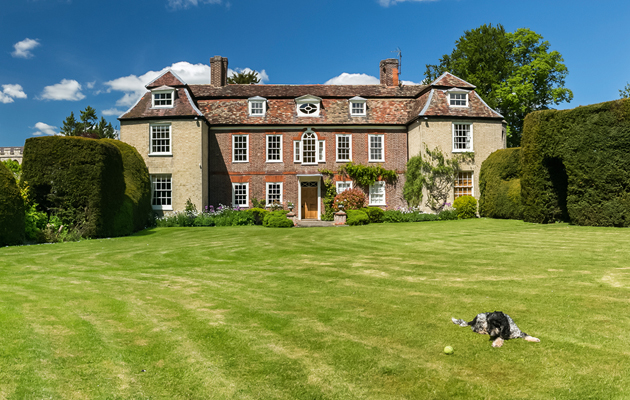Country houses and floods
Last summer’s floods were a sharp warning for many who live either in risk areas or near easily saturated ground but Cheryl Markosky suggests some preventative steps


The statistics make for stark reading: five million people in two million UK properties are at risk of being flooded. Although 10,000 properties were flooded in the autumn of 2000 in Devon, Kent, Sussex, Berkshire, Gloucester-shire and Yorkshire, resulting in £692 million of insurance claims, last summer’s floods were the worst on record since 1947, with claims totalling £3 billion. As alerts to soaring water levels become part of everyday life in many parts of Britain today flood warnings are updated every 15 minutes on the Environment Agency’s website (www. environment-agency.gov.uk) it’s increasingly important to ascertain if you’re in a flood zone, how to make sure you don’t caught out by rising tides, and what to do in a flood.
Firstly, you can check if you’re in an area that has had flooding in the past or might be likely to flood in the future by looking at the Environment Agency’s flood map on its website. Simply type in your postcode to find areas in danger of flooding from rivers or the sea, the extent of extreme flooding, and sectors protected by flood defences. If you’re buying a property in a flood zone, it’s advisable to talk to your insurance company first. Contact the Association of British Insurers (020–7600 3333; www.abi.org.uk) for a list of sympathetic insurance companies. Flood-proofing your home is a commonsense measure that could reduce problems. Sian and Bruce Webster, who own a period house in Wiltshire, were flooded in 2006 and again last July.
The problem was that water washed straight off a neighbouring field that was owned by the council and it came up through the Webster’s floor, doors and walls. ‘The council refused to put in a ditch, so we installed a monsoon drain essentially a big ditch 4ft wide and 3ft deep at the bottom of the field,’ explains Mr Webster. ‘We also painted the exterior of the house with a special mineral paint that breathes.’ Chris Pitt from the Ecclesiastical Insurance Group (0845 777 3322; www.ecclesiastical.com)favours using simple traditional methods of flood prevention, such as ‘moving sockets halfway up the wall and keeping gutters and drains clear.
In addition, don’t pave your drive and back garden completely the water needs somewhere to go.’ Sarah Staniforth, director of historic properties at the National Trust, suggests that sometimes looking to the past can help. ‘New lead roofs designed to withstand once-in-a-century deluges can’t cope water actually runs down the walls inside so we’ve started re-introducing water spouts like the ones you see on medieval cathedrals. When the hoppers are full, the water is taken outside, rather than into the building.’
If you’re unfortunate enough to be flooded, SPAB (www.spab.org.uk), which ran its first flooding course at Tewkesbury Abbey on June 20, recommends you ‘act swiftly, rather than hastily, and never remove wet plaster, joinery or other building components indiscriminately. Make sure the building is safe, and then photograph and record water damage for later insurance claims. Then, after letting the floodwater recede by itself, remove any remaining standing water and drain voids, such as under-floor spaces and electrical ducts.’ SPAB is concerned about how some well-meaning but misguided loss adjustors suggest the use of dehumidifiers and lime-plaster removal in old buildings. ‘Drying out an ancient building quickly and losing lime plaster can cause serious damage,’ cautions Douglas Kent.
● Take steps to make it harder for floodwater to enter the building—snap-on vent covers or wraparound skirts or removable door and window boards, for instance
● Standard solutions appropriate for modern buildings such as tanking and water repellents —might cause more harm than good with older properties
Sign up for the Country Life Newsletter
Exquisite houses, the beauty of Nature, and how to get the most from your life, straight to your inbox.
● Seek listed-building consent to repair older properties and engage qualified specialists. SPAB can recommend sympathetic experts (helpline Monday to Friday, 9.30am to 12.30pm, 020–7456 0916)
Country Life is unlike any other magazine: the only glossy weekly on the newsstand and the only magazine that has been guest-edited by HRH The King not once, but twice. It is a celebration of modern rural life and all its diverse joys and pleasures — that was first published in Queen Victoria's Diamond Jubilee year. Our eclectic mixture of witty and informative content — from the most up-to-date property news and commentary and a coveted glimpse inside some of the UK's best houses and gardens, to gardening, the arts and interior design, written by experts in their field — still cannot be found in print or online, anywhere else.
-
 380 acres and 90 bedrooms on the £25m private island being sold by one of Britain's top music producers
380 acres and 90 bedrooms on the £25m private island being sold by one of Britain's top music producersStormzy, Rihanna and the Rolling Stones are just a part of the story at Osea Island, a dot on the map in the seas off Essex.
By Lotte Brundle Published
-
 'A delicious chance to step back in time and bask in the best of Britain': An insider's guide to The Season
'A delicious chance to step back in time and bask in the best of Britain': An insider's guide to The SeasonHere's how to navigate this summer's top events in style, from those who know best.
By Madeleine Silver Published
-
 What to expect when you're expecting (to move to the countryside)
What to expect when you're expecting (to move to the countryside)On March 28, agents Michael Graham will be showcasing some of their best countryside properties at their west London office.
By James Fisher Published
-
 Property Talk: When is the right time to downsize?
Property Talk: When is the right time to downsize?Sometimes our homes can get too big for us, meaning it’s time to downsize. Here, we speak to those involved with the process.
By James Fisher Published
-
 How to win in the property market: Tips from some of Britain's best buying agents
How to win in the property market: Tips from some of Britain's best buying agentsWhether looking for the perfect family home or negotiating on price, buying agents do the heavy lifting–and are well used to analysing the market. Carla Passino gets advice from a few of the best.
By Carla Passino Published
-
 Top tips on renting your holiday home
Top tips on renting your holiday homeThe holiday-home market on the Cornish coast looks set for a lively summer. Arabella Youens finds out how to make the running costs bearable.
By Arabella Youens Published
-
 Tips and advice for holiday home owners
Tips and advice for holiday home ownersWith the start of the summer season nearly upon us, more and more country-house owners are dipping into the short-let scene.
By Country Life Published
-
 Property guide to Elstead
Property guide to ElsteadFreddie Mack shares the secrets of Elstead in Surrey, a prime spot for young families looking for properties outside London near good schools
By Country Life Published
-
 Property guide to Cheriton
Property guide to CheritonIf you're considering buying property in or around Cheriton this year, take a look at our property guide which covers where to buy, what prices to expect and where to have fun in the area
By Country Life Published
-
 Make your holiday let work for you
Make your holiday let work for youIf you're considering renting out your holiday property prepare by reading this first
By Country Life Published
